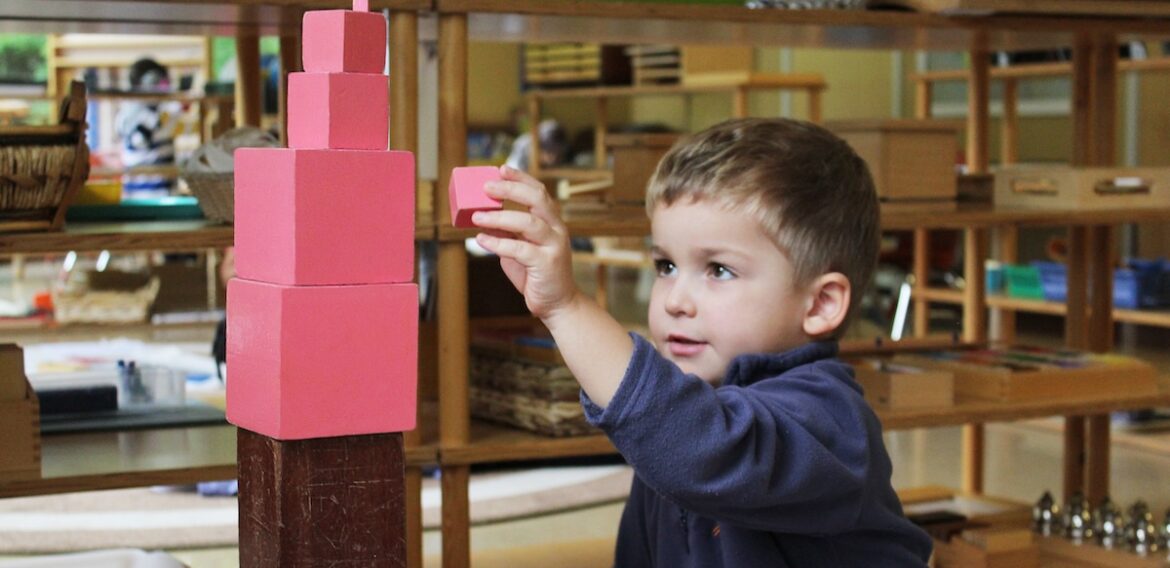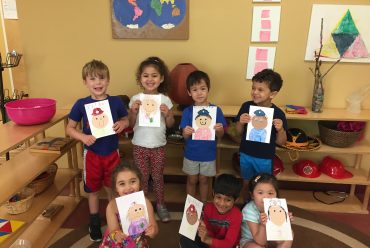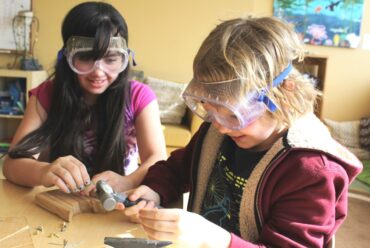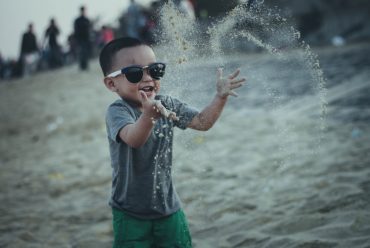Natural Born Learners – Building Foundational STEM Skills in Our Montessori Toddler Program
Many parents ask a common question when they read toddler and STEM in the same sentence, How can you develop STEM skills for 2-year-olds?
This is the beauty of the materials used in the Montessori Method. These early formative years lay the foundation for academic success. It is a crucial period when children develop basic, yet vital cognitive, emotional, and social skills. These foundational STEM skills shape everything from their personalities and attitudes to their self-awareness and confidence in learning.
The term STEM has become somewhat of a household name, especially with innovations in technology moving faster than we can keep up with. Our program includes Art, so the term STEAM is used to represent our Science, Technology, Engineering, Art, and Mathematics program.
STEAM attributes of a person’s mind, such as creative thinking, synthesizing, problem solving, organizing, persistence, and experimentation are important across all subject areas. They are essential to how children learn to learn, as well. This does not just apply to the basics like counting and vocabulary, although these skills and background knowledge are important. Stem skills are about problem solving and other higher-level skills that transfer across many disciplines but begin developing at an early age.
STEAM education provides children with essential skills and knowledge that are crucial for success in the 21st century. Research has shown that the earlier children are exposed to STEAM education, the better they perform in these subjects later in life. A study conducted by the National Science Foundation found that early experiences in science, math, and technology significantly predicted children’s interest and achievement in STEAM fields in future education`. Another study by the American Institutes for Research found that children who participated in high-quality STEAM programs in early years had higher math and science scores in later grades.
Benefits Beyond Academic Achievement
STEAM education gives young learners the opportunities to flex different muscles in their mind that foster inquiry, exploration, and experimentation. Children begin to ask questions, make intentional observations, test theories, and draw conclusions. By engaging in hands-on activities and experiments, children develop a deep understanding of scientific and mathematical principles and learn how to apply them in real-world situations, such as problem solving and innovation.
These young learners have short attention spans, so it is important that the activities and methods they use are age-appropriate and make learning fun and exciting.
Montessori methods of hands-on learning is specifically designed to develop mathematical and engineering mind among many other skills including executive functioning. All activities are broken down to their smallest denominator and move from simplest to complex, concrete to abstract. For example, initially children use the Pink Tower and Broad Stair and various kinds of cylinder activities in isolation to discriminate height, weight, size and dimension. Using these activities they also understand the concept of base 10, gradation and patterning. Later, typically around age 3, combining these materials, the children create artistic patterns and structures of their imagination, while experimenting with balance, relativity and unknowingly applying laws of physics. This is one of many examples of how the Montessori Method fosters creativity, problem solving, critical thinking and persistence.
How We Build a Foundation for STEAM at Living Montessori
We certainly do not spend a lot of time teaching our infant and toddler students long division or the Pythagorean theorem. Instead, we meet them at their level and provide them with multisensory, hands-on experiences that indirectly introduce them to STEAM in a way that engages their senses and builds curiosity.
Here are some of the ways we introduce each STEAM subject to our students.
Science
Love of science begins with exploring the rich natural world. This is something infants and toddlers are already experts at. By exposing them to environments in which they can safely engage, children learn about the way the world around them works.
Food tasting activities do more than just broaden a child’s palate and refine their senses. It’s also an opportunity to show them that even the food they eat has a story to tell. A child who is familiar with pineapple slices at snack time, for instance, is amazed to see what a whole pineapple looks like and how it grows. Food tasting and smelling then, can lead not only into exploration of new tastes, textures, and vocabulary, but build curiosity as to the relationships such as connection to the soil, roots, parts of a whole (as in the pineapple, slice being part of the whole pineapple) and interest in gardening.
Science Examples
Physical Science: Exploring the properties of objects and materials such as the difference between warm and cold water, discriminating textures (a soft and rough surface), shapes and colors.
Natural Science: Discovering the outdoor world, and the living things that are part of it and dependent on each other, through nature walks and collecting items to observe in the classroom such as rocks, sand, and petals. Natural integration of art occurs as children draw or artistically display their collection.
Technology
When we hear technology, most of us think of smartphones, computers, and complex machines. But technology really encompasses all the tools we create to make our lives easier. For toddlers, by using scissors, paper, crayons, play dough, and blocks, they learn how they can achieve various small tasks by making use of these and other tools.
Technology Examples
Practical Life Activities: Day-to-day practical activities like sweeping, wiping down surfaces, and putting away materials are an important part of the Montessori method. It also shows them how using the right technologies (even if they are very simple like brooms, dust pans, wash cloths, vacuum cleaners or gardening tools) can help them with their tasks.
Engineering
Engineering is about designing, building and action of working out fully to bring something about.
Engineering Examples
The Pink Tower, the Brown Stairs and various cylinders found in the sensorial area of a Montessori classroom are a lot of fun for children to explore and design structures out of. Children use these in isolation at first building towers by stacking them and learning about balance. Once children have practiced grading and balancing, by building towers that are stable (since the tower blocks only balance if they are in the right order), they combine the various shapes and experiment with creating interesting structures and sometimes demonstrating an artistic flare.
Art
An art education is a great way to promote the creative and expansive thinking needed to produce imaginative tasks and solutions.
We provide our students with ample opportunities to practice their artistic skills and express themselves. Our toddler rooms, for example, all have an art easel available for any child that wants to get colorful and channel their inner Van Gogh. Artistic talents are also seen coming through when children collect rocks and leaves to observe and then later put them together in an artistic design of their imagination. Children are exposed to various mediums of art, such as water color paints, crayons, scissors, paper, glue, playdough, colored pencils, and various art papers.
Art Examples
Process Art: Laying out a sheet of paper on the table and letting the students get creative with finger paints, chalk, stickers, crayons, and glue.
Project Art: Creating more deliberate art projects, like a dot art rainbow. Older students that have mastered various skills in isolation combine these foundational skills to create a variety of art projects and presentations as well as build artistic structures using the laws of physics, geometry, and math, for example.
Mathematics
So many adults have less than fond memories of learning math. Often, that’s because they were introduced to complex and abstract concepts without first exploring them in a more intuitive way.
Instead of jumping off the deep end, our younger students learn about mathematical concepts through simple, concrete, hands-on activities that involve sorting, matching, recognizing, and creating patterns, and differentiating by properties like size.
Mathematics Examples
Sorting Activities: Sorting through objects requires comparing and contrasting items based on different criteria, such as size or color. Not only is this process the basis of logical thought, but it also involves choosing which criteria to sort out by, which builds up decision-making skills and personal confidence.
Pink Tower: The Pink Tower is a classic Montessori activity that uses a set of cubes of different sizes from 1 cubic cm to 10 cubic cm. The child arranges the cubes sequentially while understanding grading and then stacks them to build a tower. By seeing the different dimensions and feeling the individual weight of each cube, the child can focus on the unique qualities of each of the cubes.
Foundational STEM Skills Fuel Your Toddler’s Creativity
In conclusion, early childhood education is a critical period for laying the foundation for future academic success, and STEAM education plays a vital role in this process. By allowing children to explore age-appropriate, purposeful activities that teach them one concept at a time and giving them the time and freedom to explore, observe and know the various properties and qualities of these materials lays a strong foundation for STEM. K-6 students apply these foundational STEM skills in our innovation makerspace, where they naturally integrate what they know to solve problems, design, and build. Our Montessori-trained teachers help children navigate a world of science, technology, engineering, and math in a purposefully prepared environment created just for their young minds. Call Living Montessori at (425) 373-5437 or schedule a tour today to fuel your toddler’s creativity!
Citations
- U. S. National Science Foundation – Directorate for STEM Education (EDU)
- Living Montessori – Building from the Imagination: Makerspace
- Living Montessori – Infant & Toddler Program
- Living Montessori – Montessori Method.







